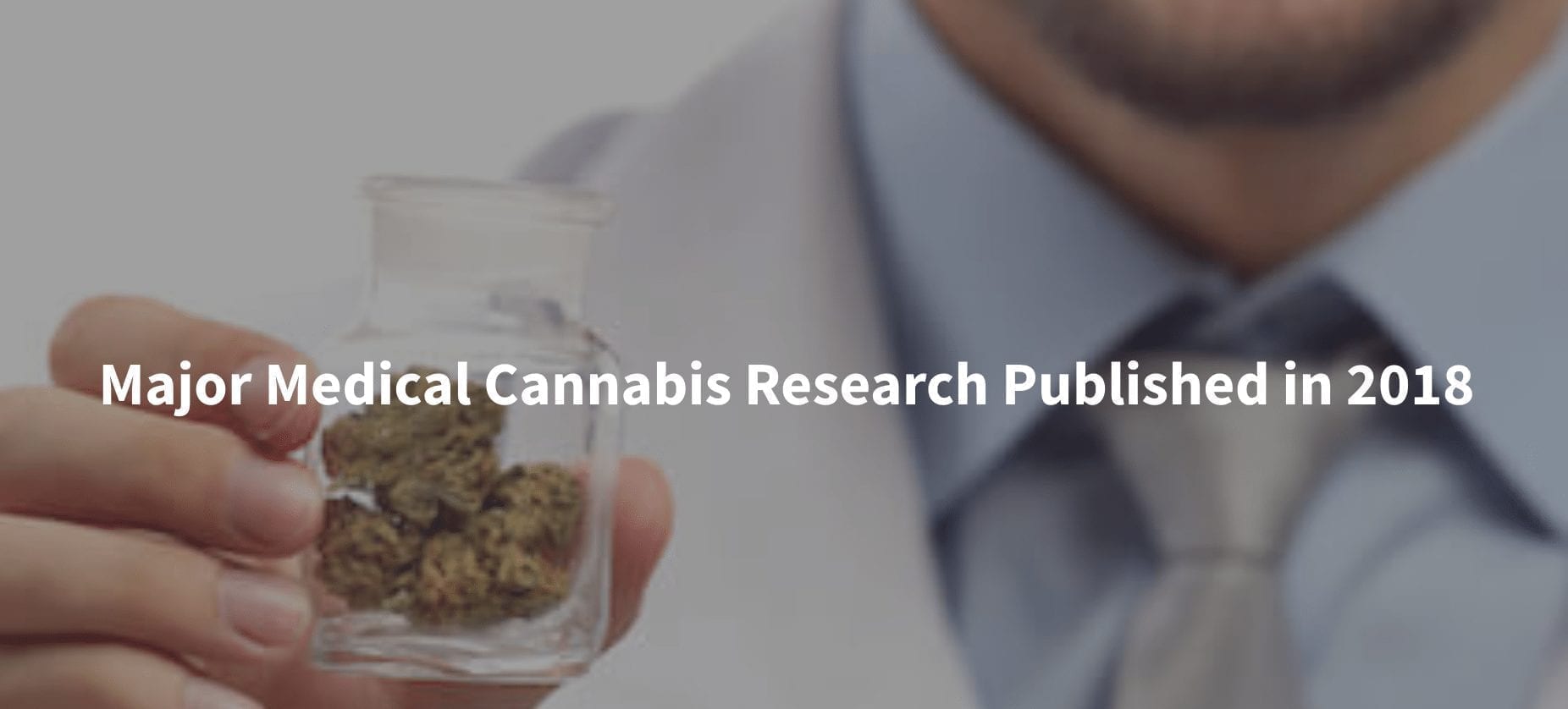Cannabis Science, Health and Wellness News, Research
Major Medical Cannabis Research Published in 2018
If you’ve read more than one of our articles, then you’ve probably seen the phrase “cannabis needs more research” at least twice, and for good reason. Cannabis’ classification as a Schedule I drug has severely impeded on our ability to research the plant as a medicine. However, that’s starting to change. As cannabis gains legal status in state after state, understanding the plant’s medical efficacy becomes a more urgent priority in the scientific community. 2018 is more than halfway over, so let’s take a look at what we’ve discovered about this fascinating plant’s medicinal properties so far.
When Combined with Cannabis, Opioid Dosage to Treat Pain Can be Reduced
 A study titled “Impact of co-administration of oxycodone and smoked cannabis on analgesia and abuse liability”and published in Neuropsychopharmacology tested the hypothesis that cannabis combined with opioidsproduces greater analgesia in addition to examining this combination’s effects on abuse liability. The double-blind, placebo-controlled study found that when cannabis is combined with opioids, pain is reduced so much so that the opioid dosage can be decreased. The study showed that the use of cannabis in combination with opioids did not increase the amount of cannabis that the subjects administered to themselves, nor did it increase cannabis abuse. However, the combination did seem to create a small increase in the addictiveness of oxycodone.
A study titled “Impact of co-administration of oxycodone and smoked cannabis on analgesia and abuse liability”and published in Neuropsychopharmacology tested the hypothesis that cannabis combined with opioidsproduces greater analgesia in addition to examining this combination’s effects on abuse liability. The double-blind, placebo-controlled study found that when cannabis is combined with opioids, pain is reduced so much so that the opioid dosage can be decreased. The study showed that the use of cannabis in combination with opioids did not increase the amount of cannabis that the subjects administered to themselves, nor did it increase cannabis abuse. However, the combination did seem to create a small increase in the addictiveness of oxycodone.
Cannabis can treat drug-resistant nausea associated with a somatoform disorder in a patient with post-polio syndrome
This small German study followed the experiences of a 79-year-old patient with post-polio syndrome (PPS), a disease that attacks patients years after they have recovered from the polio virus. The patient featured in the study experienced recurrent nausea without vomiting and abdominal pain. His physical state outside of the symptoms of the disease made therapy even more difficult to achieve—he suffered from muscular weakness, obesity, dietary-treated diabetes, and a degenerative spinal cord injury. Despite many tests, doctors could not identify the physical cause of the patient’s nausea and abdominal pain. The psychological and physical toll of the pain and the inability to find an adequate symptom-control therapy led doctors to prescribe the patient with medical marijuana. Cannabis therapy led to relief from nausea and mitigated pain. The study concluded that cannabis has the efficacy to treat pharmacoresistant symptoms associated with PPS.
Cannabis is a safe treatment option for the elderly
 Given the increased access to medical cannabis and the aging population’s knowledge about and interest in the plant as a potential therapy, this study aimed to evaluate the safety and efficacy of cannabis as a treatment for patients over 65 years old. There were 2,736 patients over 65 years old who participated in the study. They answered an initial questionnaire and then a follow-up questionnaire 6 months later concerning pain intensity, quality of life, and the occurrence of adverse events. Most of the participating patients were using cannabis to treat pain and cancer. At the 6-month mark, 93.7% of participants reported improved quality of life and reduced pain from a median of 8 to a median of 4 on a scale from 0-10. Additionally, 18.1% of patients either stopped taking or reduced the dose of opioids.
Given the increased access to medical cannabis and the aging population’s knowledge about and interest in the plant as a potential therapy, this study aimed to evaluate the safety and efficacy of cannabis as a treatment for patients over 65 years old. There were 2,736 patients over 65 years old who participated in the study. They answered an initial questionnaire and then a follow-up questionnaire 6 months later concerning pain intensity, quality of life, and the occurrence of adverse events. Most of the participating patients were using cannabis to treat pain and cancer. At the 6-month mark, 93.7% of participants reported improved quality of life and reduced pain from a median of 8 to a median of 4 on a scale from 0-10. Additionally, 18.1% of patients either stopped taking or reduced the dose of opioids.
Cannabis kills endometrial cancer cells
Cannabis is known for its palliative effects on the symptoms of cancer and cancer treatments, but studies have also shown that the plant’s compounds may stop the proliferation of cancer cells. This study examined the efficacy of cannabis on the inhibition of endometrial cancer, a cancer that begins in the lining of the uterus. The study found that cannabinoids can induce the cell death of endometrial cancer cells through the activation of TPRV1 and intracellular calcium levels. CBD showed the most promise in the modulation of cell death, making it an important subject of study for treatments of therapy-resistant estrogen-dependent endometrial cancer.
New technology developed that can provide a faster quality test for cannabis
The phytocannabinoids housed in the cannabis plant (THC and CBD, for example) are the compounds most responsible for the plant’s recreational and therapeutic properties. Detecting varying levels of the individual phytocannabinoids makes it both easier and safer for consumers to use the plant in a way that is most beneficial to them, whether for medicinal or personal use. In places where cannabis has been legalized, producers are required to submit their product for lab testing before distributing it to retailers. These tests can take as much as 20 minutes to perform, but researchers at the University of British Columbia’ Okanagan campus in Canada have developed a method that takes less than seven minutes to complete. In addition to the decreased wait time, the new method can also detect the levels of 11 cannabinoids rather than the typical 2 consumers are used to seeing on the labels of the products they buy—THC and CBD.
Smoking cannabis at 15 years old or younger is associated with drug problems at 28
While the adolescent use of cannabis is a contentious topic given the developing brain of teenagers, it would be silly to pretend that teens aren’t smoking pot. This study found that early cannabis use was associated with an elevated risk of drug abuse problems as an adult. In fact, even waiting a year can have a huge impact on the likelihood of developing a problem. The study found that if teenagers started using cannabis at 13, their likelihood of developing a drug problem by age 28 is 69%. However, if they started using cannabis at 15, the risk drops to 44%.
Medical Cannabis can be used to treat appetite loss
The findings of this study probably come as no surprise to cannabis consumers. Cannabis use has long been associated with an increased appetite commonly referred to as “the munchies.” While this may just be a normal part of the fun for recreational users, cannabis’ appetite stimulating effects can be extremely beneficial for medical patients suffering from decreased appetite, a common symptom of cancer, HIV/AIDS, heart disease, and some metabolic conditions. Appetite loss can actually reduce the chances of recovery and significantly decrease the quality of life. The study provided the science behind the lore by showing that the compounds in cannabis, especially THC, trick the brain into thinking that it’s hungry. Specifically, cannabis triggers the secretion of a chemical called ghrelin. Gherlin is a hormone the stomach releases when it is empty to signal hunger.
Read more from the source: Wikileaf.com



